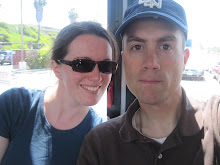
Finished! I finally made it through Fr. Luigi Gambero's
Mary and the Fathers of the Church.
While Fr. Gambero is easy to follow, I think I read this book in three different segments. I had to put it down for major life events like a move and law school finals, but also because at times it was deeply difficult emotionally. As a non-Catholic, I did not find the early Church evidence to compellingly point toward modern Catholic Marian expressions and teachings. But I don't think compelling me or making an argument was the author's intent; it should be insightful and edifying for a Catholic reader.
Fr. Gambero ended with John Damascene (d. ca. 750). It wasn't until he covered the later Church Fathers, and only by looking East, that clear expressions of Mary's mediation of all graces, her Assumption, and her Immaculate Conception began to emerge. But giving doctrinal development the room it requests, this late arrival is not of major moment for me.
What was difficult was the opening chapters, which described the spring of Marian developments from which the Church Fathers later drank, the apocryphal
Protoevangelium of James. When I read this opening, it was a time when my wife and I were a bit more caustic in our discussions about Catholicism and Orthodoxy. She thought that I was buying books only to learn arguments to support what I had already decided to do in my heart. And I wish it could have been that easy. But even in my time of eagerness, I struggled with the effect this apocryphal text later had. I learned how it "
cast an undeniable spell over the Christian mentality of the first centuries" and "
profoundly conditioned Christian liturgy, preaching, popular devotion, and art." From it we are told the names of Mary's parents, their sterility, Mary's premature birth, and Mary's presentment at the Temple. Many miraculous events are also described.
For one inclined to panic at the drop of a Marian needle, this was like a cherry bomb dropped into my trousers. It was just too much to handle, and I stopped reading this book further. I'm glad I've been able to get through it since, but still feel anxiety over the influence that this (largely tall) tale had on the Church.
I guess I need to reflect more on the belief that the Holy Spirit allows the Church to preserve and develop doctrines. This could ease my concerns over the use of texts that were outside the deposit of faith as major sources for later development.
However, concerns remain. Marian development strikes me as having a unique historical attribute. While there was great and often painful hedge trimming done in other areas of doctrinal development (for example, anathematizing predestinarianism and semi-Pelagianism alike), I don't think there was similar hedge trimming related to Marian excesses. I was hoping to see in this book that there had been some tension between various ancient scholars on the proper roles and attributes to ascribe to Mary. Instead, I found none. That may be the way the Holy Spirit has chosen to commend a truth. I simply note that it appears different from the development of other doctrine.




